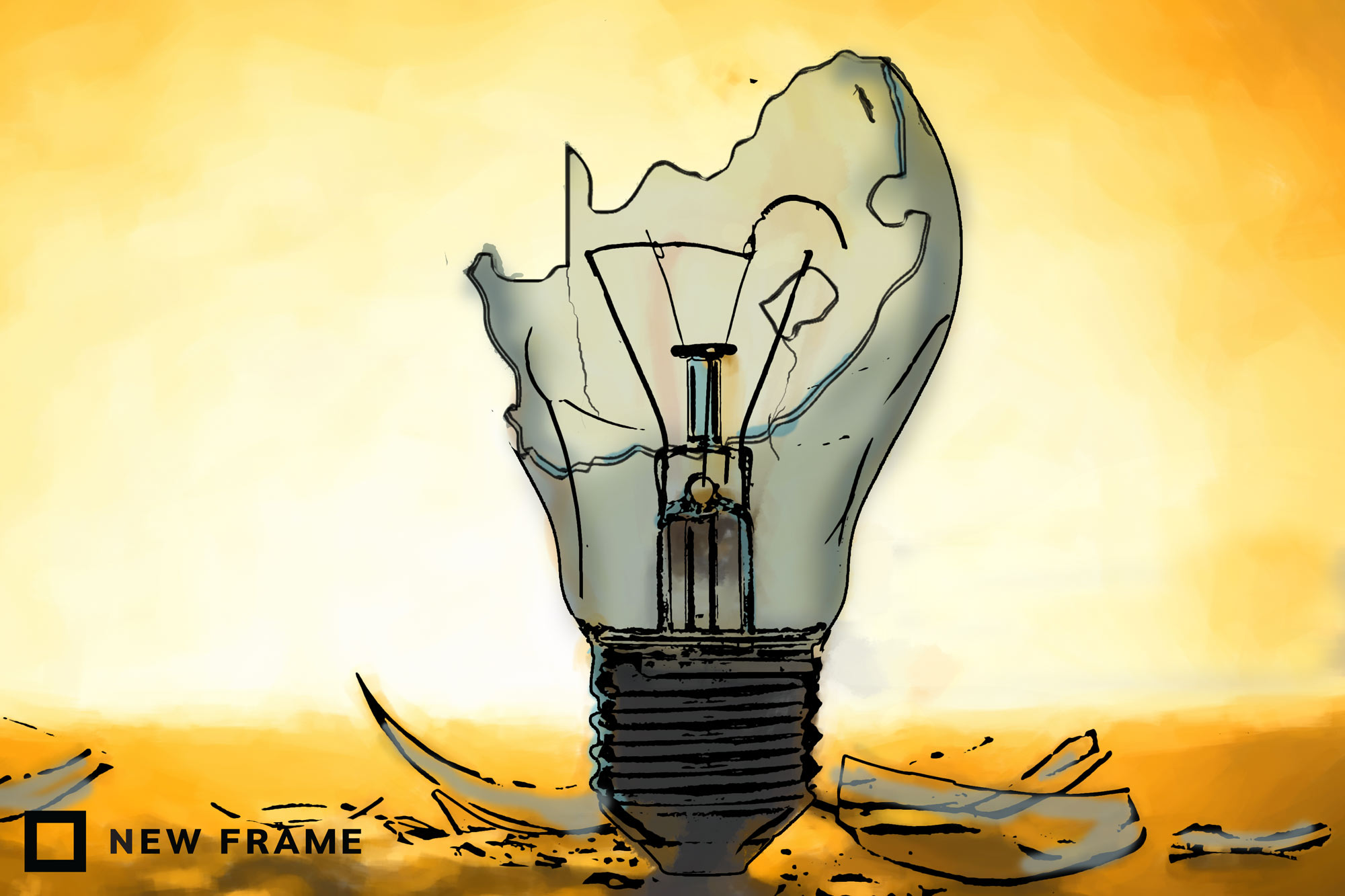The new dawn of private power
Lofty plans to boost South Africa’s energy supply are promoted by loud voices who conveniently forget that most residents are highly unlikely to gain any benefits.
Author:
13 July 2021

The crisis facing Eskom continues to be compounded by weekly accusations of corruption and controversy. Tariffs are rising rapidly, and South Africa is on track to experience the worst year of load shedding on record. Despite the frequent waves of rolling blackouts, Eskom chief executive André de Ruyter has enjoyed steady praise from mainstream media and a network of private industry lobby groups. De Ruyter’s praise has stemmed from his enthusiasm for market reforms in the energy sector, along with his attempts to reduce Eskom’s debt burden by forcefully recouping outstanding funds from municipalities.
To mitigate the looming supply shortfall, the government initiated two new market reforms to enable additional private energy generation under the Risk Mitigation Independent Power Producers Procurement Programme (RMIPPPP). The eight preferred bidders, comprising solar, wind, battery and gas projects with a combined capacity of 1 845.76MW, were announced in March.
Then, in June, President Cyril Ramaphosa lifted the threshold for private embedded generation projects needing to apply for licences from the National Energy Regulator of South Africa (Nersa) from 10MW to 100MW. His announcement came just weeks after Gwede Mantashe, the minister of mineral resources and energy, opposed extending the limit to 50MW, citing a lack of industry readiness. Ramaphosa said that raising the limit would form a key part of the Covid-19 economic recovery plan by creating an enabling environment for large power users to supplement grid power with private power purchase agreements.
These latest reforms increasing the level of privatisation in the sector are advanced with the backing of the National Treasury, which underwrites the power purchase agreements. This reduces the risk for independent power producers and ensures secure profits for private capital, while benefits trickle-down benefits to workers and communities remain but vague promises.

new Chart(document.getElementById(“line-chart”), {
type: ‘line’,
data: {
labels: [1,2,3,4,5,6,7,8,9,10,11,12,13,14,15,16,17,18,19,20,21,22,23,24,25,26,27,28,29,30,31,32,33,34,35,36,37,38,39,40,41,42,43,44,45,46,47,48,49,50,51,52,53],
datasets: [{
data: [56.71,61.1,62.96,61.33,60.44,61.09,62.46,63.69,62.76,62.81,61.5,64.23,65.12,59.5,62.94,66.72,67.82,65.92,71.28,70.59,70.66,71.82,73.33,71.76,73.07,73.26,72.91,70,70.6,69.35,70.34,69.97,67.72,63.8,65.56,67.21,63.91,64.05,66.24,67.19,64.37,66.5,65.51,64.72,65.29,64.34,62.77,59.84,60.47,60.22,60.64,57.98,54.85],
label: “Availability factor 2020”,
backgroundColor: ‘rgb(100, 100, 100)’,
borderColor: ‘rgb(100, 100, 100)’,
cubicInterpolationMode: ‘monotone’,
tension: 0.4,
fill: false
}, {
data: [56.76,57.59,58.91,58.43,57.92,58.69,59.23,59.23,60.66,60.14,59.57,60.32,59.33,61.98,63.6,65.79,64.2,64.85,63.94,64.97,63.61,64.75,65.7],
label: “Availability factor 2021”,
backgroundColor: ‘#8f0c00’,
borderColor: ‘#8f0c00’,
cubicInterpolationMode: ‘monotone’,
tension: 0.4,
fill: false
}, {
data: [29.93,26.55,24.46,28.42,26.37,24.17,22.81,24.08,24.6,28.21,27.28,26.18,23.21,16.77,17.69,18.34,16.36,20.88,19.42,19.92,15.97,16.41,18.27,16.4,18.4,17.48,19.65,20.31,18.44,19.07,18.05,18.13,17.21,20.29,20.62,16.74,21.35,19.87,18.77,15.66,17.86,18.58,18.91,20.28,16.14,16.21,17.06,18.3,20.12,19.18,18.62,19.19,21.26],
label: “Unplanned outage 2020”,
backgroundColor: ‘rgba(200,200,114,1)’,
borderColor: ‘rgba(200,200,114,1)’,
cubicInterpolationMode: ‘monotone’,
tension: 0.4,
fill: false
}, {
data: [24.63,25.31,25.03,27.13,26.48,25.21,22.87,23.34,20.29,21.92,22.68,24.49,25.41,23.63,22.35,22.04,22.59,24.01,25.04,25.7,26.96,27.85,28.5],
label: “Unplanned outage 2021”,
backgroundColor: ‘rgba(114,200,200,1)’,
borderColor: ‘rgba(114,200,200,1)’,
cubicInterpolationMode: ‘monotone’,
tension: 0.4,
fill: false
}
]
},
options: {
title: {
display: true,
text: ‘Eskom Availability and Unplanned Outage Factor (2020-21)’
},
scales: {
x: {
display: true,
title: {
display: true
}
},
y: {
display: true,
title: {
display: true,
text: ‘Factor percentage (%)’
},
suggestedMin: 0,
suggestedMax: 100
}
}
}
});
Since De Ruyter took the helm at Eskom in January 2020, power availability has dropped from 66.93% in 2019 to 65.04% in 2020, and to 61.24% until mid-June in 2021. The rate of unplanned outages has climbed rapidly this year, increasing to its highest levels of 25% to 28%. This period of deterioration has overlapped with stage four of load shedding, Ramaphosa’s 100MW deregulation announcement and the announcement of the RMIPPPP bid winners.
The militant National Union of Metalworkers of South Africa (Numsa) has accused the ANC leadership and De Ruyter of purposefully mismanaging Eskom assets to manufacture consent from the public for the privatisation of electrical generation.
“The decision announced by President Cyril Ramaphosa last week to connect more [independent power producers] to the grid outside of Nersa’s due process will only cause more job losses at Eskom. We know for a fact that this agenda is driven by the heartless, ruthless André de Ruyter whose track record has been anti-worker, anti-democratisation of the workplace, anti-transformation where his approach to turning around a business is to ‘unbundle’, ‘right-size’, sell off units and assets at the expense of the future of the company and the future of workers, their benefits and conditions,” Numsa general secretary Irvin Jim said on 13 June.
Potential consequences
Ramaphosa’s 100MW deregulation effectively stands to benefit the private development of solar photovoltaic (PV) power plants for commercial and industrial applications in, for example, mining and manufacturing.
With the increased introduction of variable energy sources, Nersa will need to play an enhanced regulatory role to ensure fairness. Ramaphosa’s exemption may also mean that the energy regulator, which is partly financed by the levies collected from electricity generators, will need to source additional funds to match the increased unlicensed activity in the sector.
Reflecting on lessons from the regulatory environment in California in the United States, a state with high solar PV penetration, Nersa member Nhlanhla Gumede, speaking in his personal capacity, raised the following: “There is a phenomenon described as the California duck curve, where the network experiences an overgeneration of power during the day – due to large solar PV presence – and rapidly falling production in the evening.
“This trend has two consequences: plants in the grid must ramp up and down daily to match the demand, and power needs to be reserved in evening peaks for users who benefit from cheap solar power during the day. Plants that are fully dispatchable to compensate for the ramping are expensive and typically include open-cycle gas turbines at R4/kWh or closed-cycle gas turbines at R2/kWh. Someone will need to pay for that.”
Related article:
Under the status quo, South Africans are primed to pay three times more for the same amount of power delivered. First, through cost overruns at the Kusile and Medupi power plants, which will significantly increase Eskom’s capacity as well as its carbon emissions. Second, through existing renewable energy independent power producer procurement (REIPPP) projects and the scheduled increased private generation from the remaining bid window four and unallocated bid window five. And third, through the recently allocated emergency RMIPPPP projects.
This alarming claim is justified by the planned increases in generation capacity, both public and private, in the context of declining electricity demand and a paradigm of cost recovery through tariff increases.
Behind the ‘good news’
Private renewables have benefitted from positive press in numerous publications as a panacea for South Africa’s lacklustre economic growth, high unemployment levels and rolling blackouts. But these accounts largely disguise the structural challenges facing the effective public provision of power. They also emphasise employment benefits that are rarely backed up by either evidence or enthusiasm from communities adjacent to existing independent power projects.
Private landowners – largely white – in areas in the Northern Cape, Western Cape and Eastern Cape, along with a growing set of local and international financial institutions, have become increasingly supportive of the policy shifts in the energy sector introduced in Ramaphosa’s “new dawn”.
Since the announcement of the controversial Karpowership contract award, strong pushback through the media has come from pro-renewables actors from across the political spectrum. They notably include environmental organisation 350.org, energy analyst Chris Yelland, University of Cape Town Graduate School of Business professor Anton Eberhard and investigative journalism centre amaBhungane, among others. A common thread has been accusations of corruption linked to preferential treatment in the bidding process and unjustified exemptions of environmental impact requirements.
Related podcast:
Many lobbyists have since gone further to suggest renewable energy projects could provide cheap, optimal solutions to the energy crisis with significant downstream employment benefits for communities. They have used theoretical models and cost prices while conveniently ignoring the existing expensive solutions put forward by actual renewable energy developers, or questioned the rationale of the RMIPPPP altogether.
What remains remarkably absent from these accounts is a sober assessment of the behaviour of the existing renewable energy industry. Many REIPPP projects have consistently tried to bypass and undermine local content requirements, insisting on the need to import key components. Less than 10% of the manufacturing capacity of solar module production in South Africa has been used, despite the growing increase in private solar procurement. REIPPP projects also struggle to meet employment targets set by the government and benefit from opaque reporting criteria, which disguise the casual and temporary nature of the opportunities created for the majority.
The reality on the ground
It is no wonder then that the nation has yet to hear residents in the Northern Cape, the largest “beneficiary” of renewable energy projects, independently signal their optimism for the green “win-win” economic recovery plan. In a 2017 financial census of municipalities issued by Statistics South Africa, the province, which has five district and 26 local municipalities, showed the second-largest growth of year-on-year municipal debt levels.
In October 2020, battling local municipalities in the Northern Cape – Tsantsabane (Postmasburg), Magareng (Warrenton), Richtersveld (Port Nolloth) and Khâi-Ma (Pofadder) – were threatened with imminent power cuts owing to their inability to pay outstanding debts to Eskom, resulting in renegotiated payment plans.
Well-resourced municipalities are gearing up to implement private renewable energy procurement programmes modelled on REIPPP projects to mitigate against the unreliable supply from Eskom. Under the status quo, municipalities raise capital for their activities primarily through rates collection (water, electricity and waste removal tariffs). With Eskom’s proposed move to cost-reflective tariffs, both it and the participating municipalities will be allowed to pass the cost of new private generation projects on to consumers.
Related article:
The net impact of these developments come against the backdrop of stalled wage negotiations between Eskom and trade unions Numsa, the National Union of Mineworkers and Solidarity. De Ruyter thus far failed to renegotiate REIPPP projects to reduce costs and continued to support measures to unbundle the utility. The historical gains in wages, occupational health and safety and social security benefits for energy workers at plant level are rapidly being eroded, while control is steadily and deliberately transferred to private capital.
Whether through Karpowership contracts, REIPPP projects, or inflated and corrupt coal procurement, South Africans remain caught in a conflict between black and white sections of the elite that overlap and compete for control of the pathways to capital accumulation. South Africa’s working class cannot carry the weight of the energy transition while the elite ensures high levels of profitability for themselves through either corrupt or legal means.
The further acceleration of market reforms will result in quick money for finance capital and perhaps a handful of politicians, while ensuring the collapse of the prospects of universal provision of basic services for the working class.
As changes in the energy sector continue to unfold, the downstream implications for marginalised communities will not be greeted quietly, if our history is anything to go by. An unjust energy transition will be met by protest, fire and boycott until a new dawn is realised.



